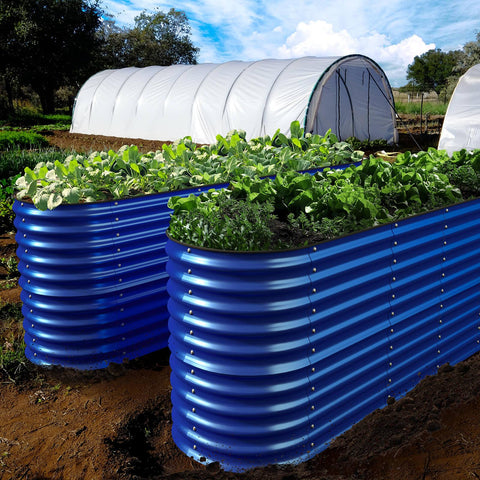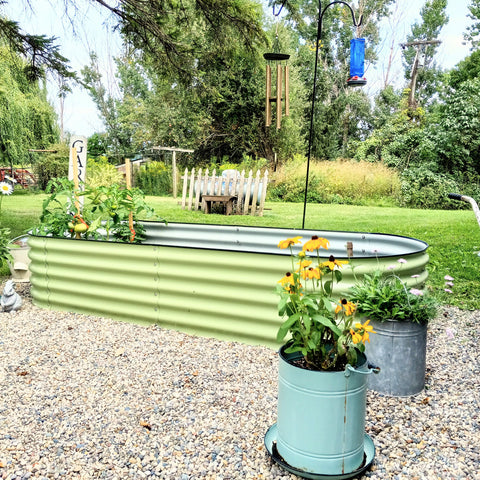Knowledge from Olle Garden Bed: Basic Winter Maintenance of Vegetable Garden
Winter is usually regarded as a quiet time for gardeners, but even in places where the soil is frozen and there is snow on the ground, there are many important jobs to keep you busy. When the weather warms, the preparations made now will be rewarded many times, which is why I have compiled my best suggestions for winter preparation below. The following content also has some reference value for raised garden beds.

Good planning of vegetable garden
The value of planning ahead for the growing season should never be underestimated Think about what was done well and what was not done well in the garden last year - which vegetables were so popular, you could never eat enough, which vegetables were surplus, or even could not give up? Deciding what not to plant is as important as deciding what to plant. For example, last year I finally dug up my very successful rhubarb plant and donated it to the horticulture department of the local university, because I found that all my friends and family either had their own rhubarb or hated its taste!
Check the old seed packs to see if there are any remaining seed packs to be sown this year, but remember that the germination rate may decline over time After you have evaluated the seeds you already have, browse the directories of some seed companies to get fresh seeds. It's always fun to try new varieties and grow them with old favorites you know are doing well. Why not try purple carrots, lemon coriander or pointed broccoli? Who knows, you may even find your favorite new vegetable!
Garden maintenance
Most sheds and ancillary buildings will benefit from some maintenance and repair in winter. The paint may be too cold, but it is still worth checking and repairing any loose or rotten panels and making sure the door hinges are in good condition to help eliminate airflow. Sharpening and oiling the blades of gardening tools – I have found that vegetable oil is as effective as more expensive (and less environmentally friendly) oils, and it can also be used for wooden handles of tools.
If you have a greenhouse or cold shelf, then the glass and surface also need to be well cleaned and scrubbed flower pots and seed trays You can also create a "hotbed" system that has been used since the Victorian era to provide bottom heat for winter salad crops and early planted seedlings. The hot bed consists of a deep layer of fresh straw manure, covered with an equal amount of topsoil and garden compost mixture. When the excrement rots, it generates heat, which will warm the soil above it - place it for about a week before planting to heat it to ensure that it is ready for seedlings.
Prepare the ground
If the ground is feasible and not frozen, winter excavation can be carried out now, but first consider whether it is necessary. Digging can disrupt the soil structure and beneficial soil organisms, so dig only when the soil is really needed - for example, when starting a new plot, or if you had a serious insect problem last season and you want to expose any grubs or wintering pests for birds to eat. However, if your soil is very heavy clay, you may find that you need to dig it every year to improve its structure and drainage, and add a lot of rotten compost.

Perennials and overwintering crops
Many fruit trees and shrubs can now be trimmed to ensure that stakes and ties on existing fruit trees are in good condition.
Depending on the weather, you can continue to harvest some vegetables, such as turnips, cabbage, chicory and kale. After harvesting the tough stems of brassica, dig a ditch as deep as a shovel. This year, you will plant peas or beans there, then place the stems of brassica on the bottom of the ditch, and cut them with a sharp shovel. You can also add other vegetable residues - this compost ditch will provide wonderful organic (and free!) for your beans Slow release fertilizer.
Weeds, mulch and plastic bottles
What else can you do? Well, it depends on your climate and the mildness or harshness of this winter, but there may be weeds that need to be treated. Straw or wool mulch should be used for winter crops, or snow accumulation should be knocked off from the plants. You need to regularly check any stored fruits and vegetables, and delete any deteriorated things.
One of my essential items in the garden is simple plastic bottles, so I usually start to collect them now as cheap and cheerful bell covers for seedlings. They are filled with water and can also be placed in a cold frame to absorb the heat of the sun during the day and then release the heat at night, helping to prevent frost and protect early seedlings at the beginning of the growing season.
